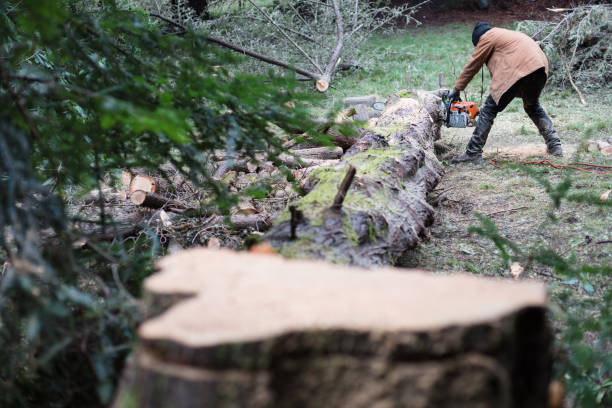When you think about tree removal, it might not be immediately obvious how critical it is for protecting your home. Stable or dead trees can become major hazards, especially during storms where high winds can easily cause branches to snap or entire trees to uproot. But it’s not just about what’s above ground; roots extending beneath your foundation can lead to cracks and soil shifts, potentially compromising your home’s structural integrity. By addressing these issues proactively, you can prevent costly repairs and ensure your home remains safe. Curious about the steps you should take?
Preventing Structural Damage
Tree removal plays a crucial role in preventing structural damage to your home. Trees, especially older ones, can significantly threaten your property. Their large branches can break off during storms, potentially crashing into your roof or windows. Over time, even healthy trees can become unstable, and the risk of branches falling increases.
You’ve also got to consider the root system. Tree roots can grow underneath your home’s foundation, leading to cracks in walls or floors. Even if they don’t go that deep, they can still cause sidewalks and driveways to buckle, creating trip hazards and damaging concrete. By removing problematic trees, you’re protecting your home and your family’s safety.
Additionally, certain trees are more prone to pests and diseases, which can spread to other parts of your property. Dead or decaying trees attract termites and other insects that can infiltrate your home, causing further structural issues. Regularly inspecting and removing unhealthy trees can save you from costly repairs and pest control treatments.
Avoiding Foundation Issues
Foundation issues can be a homeowner’s nightmare; trees are often the hidden culprits. When trees are planted too close to your home, their roots can extend far and wide, seeking out moisture. This can lead to significant problems if they find their way under your foundation. As roots grow, they can cause the soil to shift, which puts pressure on your foundation and leads to cracks and instability.
You might think that small trees aren’t a threat, but even modest-sized ones can grow substantial root systems over time. The roots can leach moisture from the soil, causing it to contract and create voids under your foundation. This can result in uneven settling, compromising your home’s structural integrity.
Moreover, tree removal can be a proactive measure to prevent these issues before they escalate. By removing trees that are too close to your home, you can ensure that their roots don’t have the opportunity to cause damage. It’s not just about cutting down the tree; it’s about preserving the stability and safety of your home for the long term. A little foresight can save you from costly and extensive foundation repairs down the line.
Mitigating Storm Risks
During stormy weather, the trees surrounding your home can pose significant risks. High winds and heavy rain can cause branches to snap or entire trees to uproot, potentially damaging your roof, windows, or structure. By removing vulnerable trees, you’re reducing the chances of these dangers occurring.
First, assess the health of your trees. Dead or dying trees are more likely to fall during a storm. Look for signs like cracked trunks, dead branches, or fungal growth. If you notice any of these, removing the tree before the next big storm hits is a good idea.
Second, consider the proximity of trees to your home. Even healthy trees can be hazardous if they’re too close. Saturated soil can destabilize roots, making the tree more prone to falling. Additionally, overhanging branches can break off and cause severe damage.
Third, think about the direction of prevailing winds. Trees that lean towards your home are hazardous. Removing these trees can prevent them from being pushed over in a storm.

